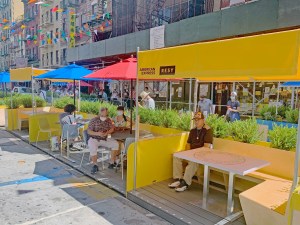Chinatown Sees Car-Free Mott Street as a Road to Recovery

Call it Mott haven.
Chinatown leaders hope to restore business by barring cars from a block of historic Mott Street to create an open restaurant zone in the heart of the COVID-battered neighborhood.
On Wednesday morning, the Chinatown Partnership and the Rockwell Group — an architecture firm that has been donating its services to help the restaurant industry — will show off the fruit of several days of labor: seating areas that repurpose the narrow roadway between Mosco and Worth streets for dining.
“Business before … was quite slow,” said Brian Hong of Ajisen Ramen as he watched workers transforming the street. “It will attract more customers. It’s an upgrade [that will] give much more comfort and safety for customers.”
Hong also liked that the Rockwell Group designed the seating areas on the block for all the restaurants to use.
“Everybody’s getting a makeover, so it comes down to what kind of food the customers wants to eat,” he said.

In the city’s official “Open Streets: Restaurants” plan, only one-block — Doyers Street, which was already largely car-free — had been set aside for dining in the street. And that program only runs on weekends. But the Chinatown business improvement district got permission from the city to do more.
David Rockwell, the longtime restaurant architect, said he’s been helping restaurants get back on their feet for two reasons: because they’re crucial to our economy and because they point the way forward for the streetscape (a second “community-wide dining area” will be built soon in Queens, but Rockwell did not say where).
“Restaurants,” he said in a statement, “create a sense of urban vitality by serving neighbors and visitors and attracting people to different parts of the city. What happens on our sidewalks and streets, we are learning, is critical to how we pull through this as a city. It is a moment for us to rethink the value of urban space and ensure that it is used to the benefit of the city.”
DOT Commissioner Polly Trottenberg called the Chinatown plan an “inspired car-free use of our public spaces.”
The Rockwell Group participation is part of a joint effort with the New York City Hospitality Alliance — a restaurant group — to create “DineOut NYC” to help restaurants transition to outdoor dining as part of the city’s expanded al fresco operations. More than 9,400 restaurants have set up tables on sidewalks and in curbside spaces under the city’s self-certification program.
“Restaurants are the heart and soul of Chinatown, but they’ve been devastated for months due to the pandemic and the xenophobia that has grown with it,” said the neighborhood’s Council Member, Margaret Chin. “Now, thanks to the DineOut NYC initiative, we have an opportunity to dramatically transform and activate Mott Street through an exciting communal outdoor dining design.”
In Chinatown, Rockwell has financial backing from Moet Hennessy, Resy, American Express and the Pershing Square Foundation, plus Daniel Stern, Lizzie and Jonathan Tisch and Nina and Tim Zagat, the company said in a statement.



